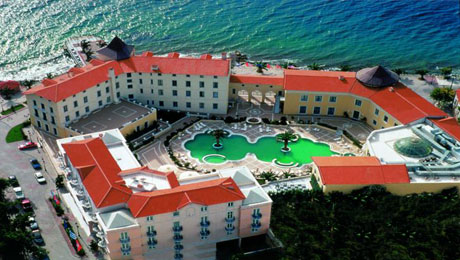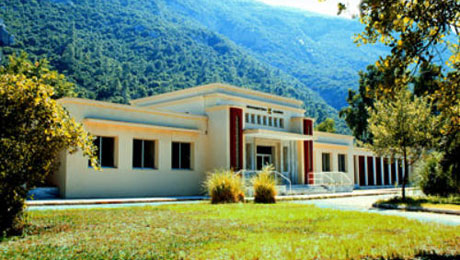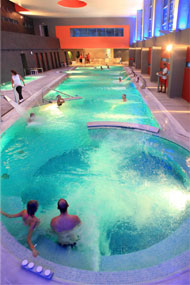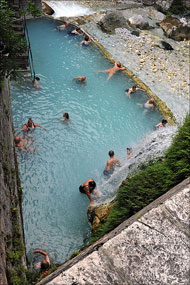Picture: www.clickatlife.gr
Some of the most significant Greek balneology centres
The Ancient Greeks were the first to use thermal baths and ancient Greek physicians, physicists, historians and geographers were among the first who dealt with springs and mineral waters. Towns with thermal baths encourage the development of health tourism. These are well organised centres that have the necessary facilities providing therapeutic and beauty services. According to their natural position, they are divided into centres for hydrotherapy (with mineral or sea water) and climate therapy centres (with a suitable climate).
Here are some of the most significant balneotherapeutic centres in Greece, with hot springs, which are suitable for the treatment of many diseases.
Edipsos (the island of Evia)

Picture: www.clickatlife.gr
The thermal baths of Edipsos make the city the biggest spa town in Greece, with hot springs beneficial for many diseases. Roman General Silas founded the first thermal baths here. In the 20th century, a new town was built in neoclassical style, with hotels and private clinics. Today, there are more than 80 springs, the temperature of which ranges from 28 to 86 degrees Celsius. Their waters are beneficial for respiratory, rheumatic, gynaecological and skin diseases, diseases of the liver and kidneys.
The luxurious Thermae Sylla Spa Wellness Hotel, which has existed since 1897, has been renovated and is now making spa tourism in Greece once again the order of the day. In addition to private clinics in and outside hotels in the form of ordinary thermal baths or swimming pools, there is a spa centre of the Greek Tourist Organisation in the city that provides all kinds of treatment options with modern techniques. The public beach covers the needs of all who want to combine mineral baths with sea waters.
Kamena Vourla

Picture: www.clickatlife.gr
Kamena Vourla’s mineral springs became known in 1926, when it was discovered that they contain radon at levels that are unique and higher compared to all similar European springs. Thus, in the 1930s, people started using them and the first modern hotels were built in the city. After the Second World War, famous people from around the world came to Kamena Vourla. The city’s springs are located at the foot of Knimida Mountain, some 300-400 metres from the shore. Their therapeutic properties are beneficial for the treatment of arthritis, as well as various rheumatic, vascular and gynaecological diseases.

Loutraki, Corinthia
Loutraki has been famous for its mineral waters since 1925. The springs are located in various places in the coastal area that has a total length of about 750 metres at the foot of Gerania. They have sprung from a great depth for thousands of years. The water is filtered by rocks and enriched with rare metals. You can choose from various programmes for mineral water treatment, depending on the condition concerned. The healing properties of the waters aid the treatment of diseases of the digestive system, liver failure and kidney diseases. The Greek Tourism Organisation has a spa centre here - a wonderful building from the era between the two world wars, with notable mosaics.

Pozar (Pella region)
This centre is located in a green forest some 13 km northwest of Aridaia, at the foot of Voras Mountain. It is 100 km from Thessaloniki and 550 km from Athens. Its mineral springs come from a depth of 390 m and are formed by rainwaters that enter the soil at a great depth, where they are heated and gradually enriched with metals and other elements. Their temperature is 37 degrees Celsius. In a relatively small area, there are hotels, swimming pools, restaurants and bars that offer everything.
The healing properties of the waters have beneficial effects for the treatment of diseases of the circulatory and respiratory system, rheumatic, gynaecological and skin diseases. The waters are also useful for the treatment of liver, kidney and gall bladder diseases, as well as diseases of the digestive and excretory system.
Ipati

Picture: www.clickatlife.gr
The town became a spa centre in the 19th century. Its springs have been known for their healing properties since the 4th century BC. There are many hotels, some of which were built in the late 19th and early 20th century, but there are also a lot of new hotels.
The waters are beneficial to people who suffer from vascular disorders, cardiac failure, diseases of the nervous system, skin disorders, etc.
Sidirokastro, Serres

Picture: www.clickatlife.gr
The waters here have a temperature of 45 degrees Celsius, and the springs are located north of Sidirokastro, near the railway bridge over Strymonas River (Struma). The mineral springs have been known since the Byzantine era and are beneficial to rheumatic diseases, diseases of the spine, disc hernia, myalgia, arthritis, and gynaecological diseases.
Kyllini